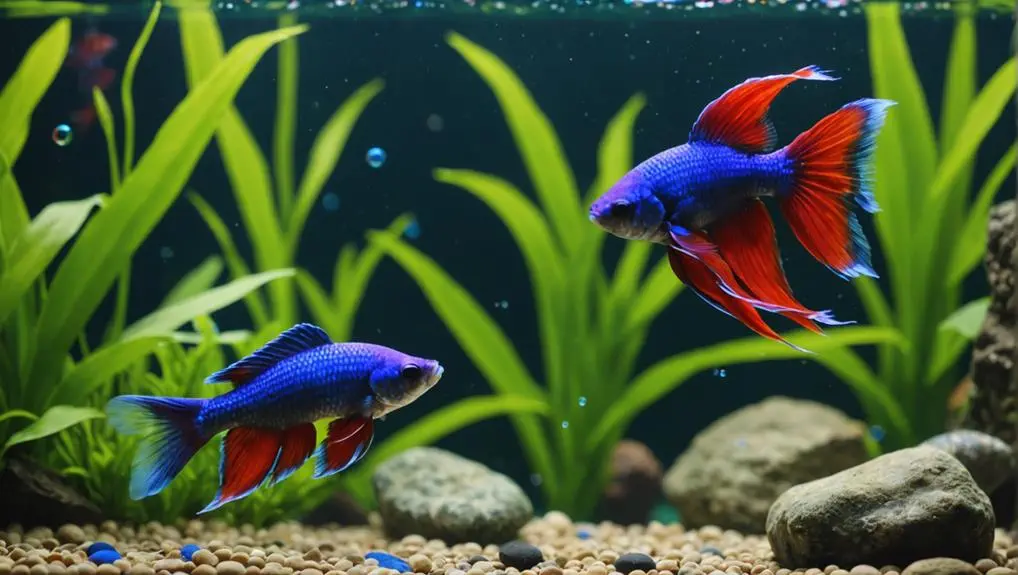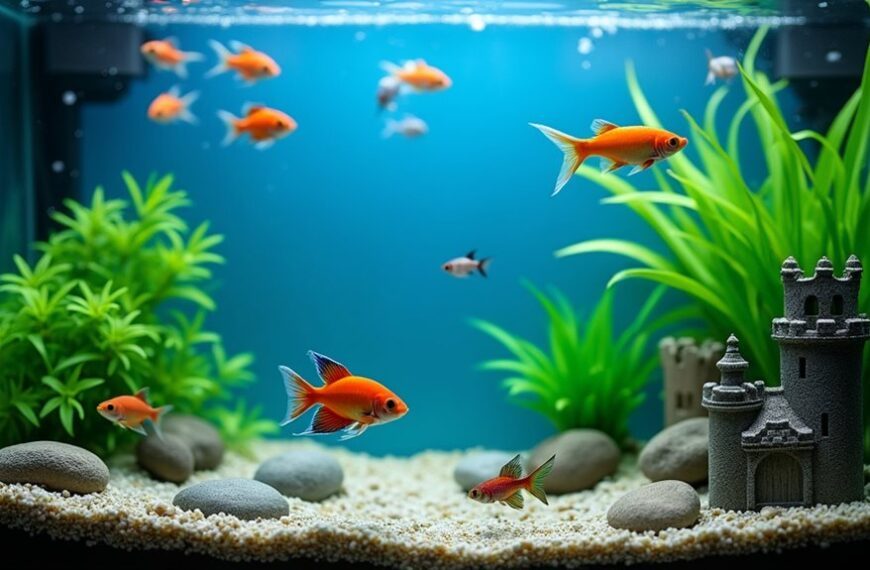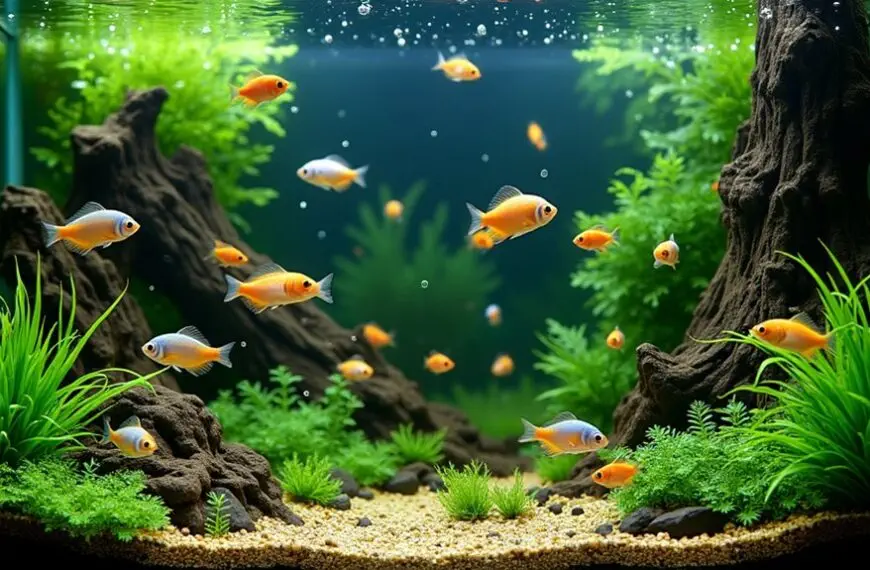If you're starting an aquarium, you've got some fantastic fish options to make things easy! Goldfish are super hardy, and bettas bring color and personality to your tank. Neon tetras are small, peaceful, and love to school together. Don't forget about livebearers like mollies and guppies, who make friendly community companions. Zebrafish and Cory catfish are active and helpful, keeping your tank lively and clean. With cherry barbs and white cloud minnows, you'll have a vibrant mix that's fun to watch. Each fish has its own quirks, so stick around to learn a bit more!
Contents
- 1 Goldfish Varieties for Beginners
- 2 Betta Fish Care Essentials
- 3 Neon Tetra Characteristics
- 4 Livebearers: Mollies and Platys
- 5 Active Zebrafish Traits
- 6 Harlequin Rasbora Overview
- 7 Cory Catfish Benefits
- 8 Cherry Barb Features
- 9 Guppy Care Tips
- 10 White Cloud Minnow Insights
- 11 Frequently Asked Questions
- 12 Final Thoughts
Goldfish Varieties for Beginners
When you're starting out in the world of fishkeeping, goldfish are an excellent choice. With their vibrant colors and charming personalities, they can bring joy to any home.
For beginners, several varieties, like the comet, sarasa, and shubunkin, are perfect. These goldfish are known for their resilience and low care requirements, making them ideal for novice aquarists. Additionally, goldfish can adapt well to various water conditions, which is a significant advantage for those just starting out in the hobby. It's important to keep in mind the ideal tank conditions necessary for goldfish care to ensure their health and wellbeing.
However, it's essential to remember that goldfish can grow quite large—up to 12-14 inches! To keep them happy and healthy, you'll need at least 30 gallons of water per fish.
They're also omnivorous, so a balanced diet of spirulina algae, vegetables, and low-protein foods will keep your finned friends thriving.
While goldfish can be great companions, they mightn't play well with others. Due to potential aggressive behaviors, it's often best to keep them in a single-species aquarium.
This way, you can maintain good water quality and ensure they feel safe and secure. So, whether you're starting a community tank or focusing solely on goldfish, you're sure to find joy in their company and learn plenty along the way!
Betta Fish Care Essentials
Betta fish enthusiasts know that these vibrant creatures, also known as Siamese fighting fish, require specific care to thrive. To keep your betta fish happy, start with a tank size of at least 5 gallons. This gives them enough space to swim around and stay healthy.
A well-decorated tank with safe materials can also enhance their well-being by providing hiding spots and structures for exploration, mimicking their natural habitat and reducing stress provides hiding spots. A filter and heater are essential, as bettas love stable water conditions between 78-82°F.
Remember, males are territorial and shouldn't be housed together—trust me, you don't want to witness a fish fight! However, if you're thinking about keeping females, they can live together in a sorority of 5-6 fish.
Feeding your betta is fun! They thrive on high-quality pellets made just for them. Occasionally treat them with live or frozen foods for a nutritional boost. Just be careful with decorations; avoid anything sharp that could cause fin damage, as those flowing fins are part of their charm.
Lastly, don't forget about water changes! Aim for at least 25% weekly to keep their environment clean and healthy. With these essentials, you'll be well on your way to creating a happy home for your betta fish!
Neon Tetra Characteristics
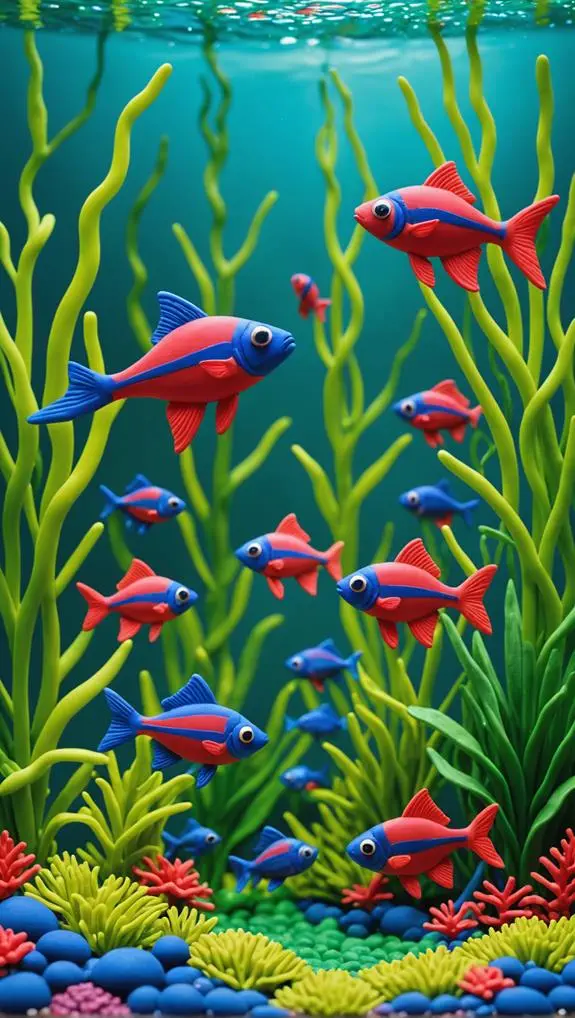
If you're looking to expand your aquarium beyond betta fish, neon tetras could be the perfect addition.
These small, brightly colored fish aren't only easy to care for but also bring a vibrant touch to your community tank.
With their peaceful demeanor, they're known to be compatible with other small fish, making them a great choice for a community tank dynamics.
Here are three key characteristics that make them a fantastic choice for beginner aquarists:
- Small Size: Neon tetras typically grow to about 1.5 inches, so they fit well in any size aquarium without overwhelming the space.
- Schooling Fish: They thrive in groups of at least 5-6 individuals. This schooling behavior reduces stress and encourages their natural social interactions, making your tank livelier.
- Water Conditions: Neon tetras prefer slightly acidic to neutral water (pH 6.0 to 7.0) and temperatures between 70-81°F. Keeping these conditions stable will keep your fish happy and healthy.
Their peaceful nature makes them perfect companions for other small community fish.
Plus, their striking blue and red colors can brighten up any aquarium.
Livebearers: Mollies and Platys
When you think about adding livebearers like mollies and platys to your tank, you're in for a treat!
These fish aren't just pretty faces; they're tough and adaptable, making them perfect for beginners.
Plus, they're social creatures that love hanging out in groups, which makes watching them interact a delightful experience!
Care Requirements Overview
Although both mollies and platys are easy to care for, understanding their specific requirements is crucial for keeping them healthy and thriving. These lively little fish make fantastic additions to your community tanks, but you'll want to pay attention to a few key care aspects.
- Water Quality: Both species prefer a pH level around 7.0 and thrive in temperatures between 72-78°F. Regular water changes of 10-15% weekly are essential to maintain their vibrant colors and overall health.
- Diet: Mollies enjoy a varied diet that includes spirulina algae and plant matter, while platys are omnivorous. Don't forget to mix in flakes, pellets, and some veggies for a balanced feast!
- Social Needs: Keep these fish in groups of 3-6 to encourage social interaction. They grow to about 2-3 inches, making them perfect for smaller tanks. Just be mindful of their breeding; managing their populations prevents overcrowding.
Following these simple care guidelines will ensure your mollies and platys flourish, creating a lively and colorful atmosphere in your tank. Happy fish-keeping!
Social Behavior Traits
Mollies and platys exhibit fascinating social behaviors that make them ideal choices for beginner aquarists. These social fish thrive in groups, which means you'll want to keep at least five of them together. This not only reduces stress but also allows them to display their natural antics, like playful swimming and socializing with one another.
Platys are known for their peaceful temperament, making them perfect companions for various community fish. You'll love watching them peacefully coexist, adding a splash of color and life to your aquarium.
Mollies, too, are hardy and adaptable, meaning they can tolerate different water conditions, a real blessing for novice fishkeepers.
Both species are livebearers, giving birth to live fry instead of laying eggs, which adds an exciting twist to your fishkeeping journey. Just keep in mind that they're prolific breeders, so monitoring their population is essential to avoid overstocking.
Active Zebrafish Traits
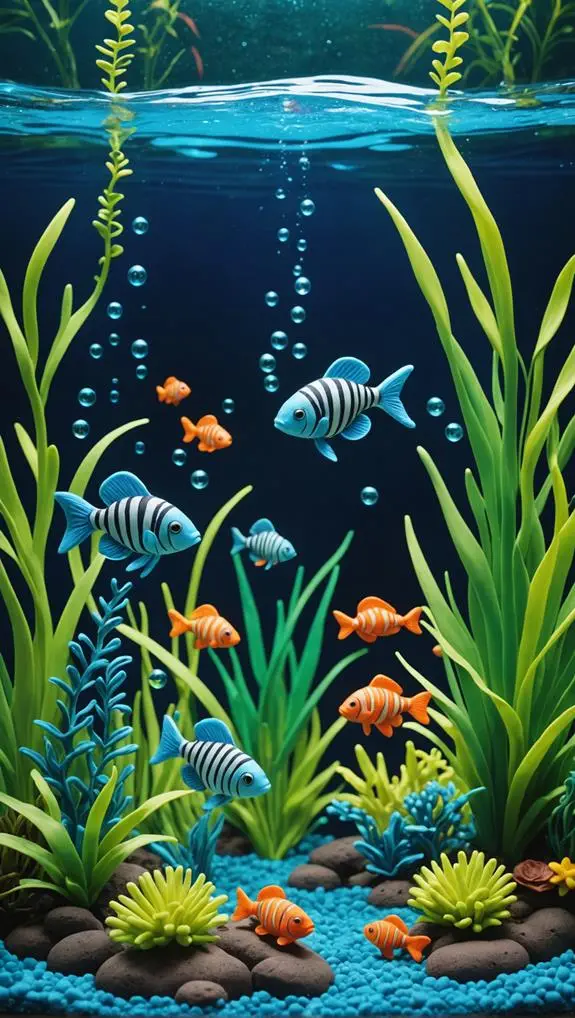
Zebrafish's lively nature makes them a favorite for beginners in the aquarium hobby. These small, active swimmers bring joy and excitement to any well-maintained tank. Watching them dart around can be a delightful experience!
To help you understand why they're so great, here are three key traits:
- Social Butterflies: Zebrafish thrive in schools of six or more. This not only boosts their happiness but also reduces stress. You'll love seeing their natural behaviors unfold as they swim together.
- Adaptability: These tropical fish can handle a wide range of water conditions. They prefer temperatures between 64-75°F and a pH of 6.5-7.5. So, you don't have to lose sleep over perfecting your tank's water!
- Easy Nutrition: Feeding zebrafish is a breeze! They enjoy flakes, pellets, and even live or frozen foods. With a balanced diet, you're ensuring their nutrition for growth and health.
With their colorful appearance and energetic antics, zebrafish make it easy to keep fish that brighten your day. You'll find that they're not just fish; they're little bundles of joy!
Harlequin Rasbora Overview
If you're looking for a colorful addition to your aquarium, the Harlequin rasbora is a fantastic choice.
These little fish thrive in schools, so you'll want to gather at least six of them to keep the peace—after all, who wants a tank full of drama, right?
With the right tank conditions, like stable temperatures and a few plants, you'll create a cozy home where they can show off their vibrant colors and social behavior!
Ideal Tank Conditions
Creating the ideal tank conditions for Harlequin rasboras is essential for their health and happiness. These charming freshwater fish thrive in a well-planted aquarium, so let's make sure your setup is perfect!
Here are three key points to consider:
- Minimum Tank Size: You'll need at least a 10-gallon tank to accommodate their schooling behavior. Harlequin rasboras love to swim in groups, so a bigger space is always better!
- Water Parameters: Aim for a water temperature between 72°F to 79°F, with a pH range of 6.0 to 7.5. They're pretty adaptable, but keeping these water parameters stable will help them flourish.
- Schools: Always keep at least six of these beautiful fish together. Not only does this promote their natural social dynamics, but it also reduces stress. Plus, they get along well with other community fish, making them an easy choice for beginners.
With a little effort, you'll create a thriving environment for your Harlequin rasboras, where they can swim happily and show off their stunning colors.
Happy fish-keeping!
Social Behavior Traits
Harlequin rasboras aren't just visually stunning; their social behavior is equally fascinating.
These small freshwater fish thrive in groups, so think of them as the social butterflies of your aquarium. Ideally, you'll want at least six of them to create a lively atmosphere in your community tank. Their peaceful temperament means they get along well with other non-aggressive fish, which is a huge plus if you're looking to create a harmonious underwater world.
Their social nature shines when they've plenty of hiding spaces in well-planted tanks. Imagine your rasboras darting in and out of lush greenery, feeling safe and secure. This not only reduces their stress levels but also adds a beautiful dynamic to your tank.
Plus, their vibrant colors—pinkish-beige bodies with striking black markings—will undoubtedly catch your eye as they swim together.
Cory Catfish Benefits
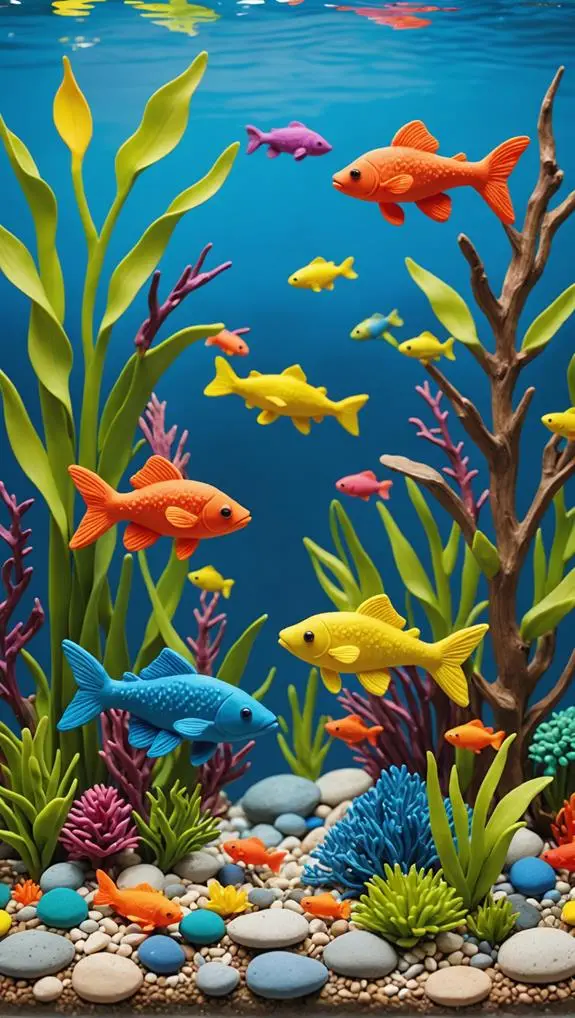
Cory catfish offer numerous benefits for beginner aquarists, making them a fantastic choice for community tanks.
These peaceful bottom-dwellers not only coexist well with a variety of fish, but they also bring a unique charm to your aquarium.
Here are three key advantages of having cory catfish:
1. Scavenging Habits: With their natural scavenging instincts, cory catfish help maintain cleanliness in your tank.
They'll happily munch on leftover food and detritus, reducing the need for frequent clean-ups.
Who wouldn't want a little less work?
2. Community-Friendly: Cory catfish thrive in groups, requiring a minimum of three to six individuals.
This schooling behavior not only keeps them happy but also creates a delightful spectacle in your aquarium.
Watching them dart around can be quite entertaining!
3. Simple Care: They're simple to care for, making them perfect for beginner aquarists.
Just provide sinking pellets and occasional treats, and you're all set.
Plus, their small size (2-4 inches) means they fit well in both small and large tanks.
Cherry Barb Features
Cherry barbs are a vibrant addition to any community tank, known for their striking red coloration, especially in males. These little gems grow up to 2 inches and love to swim in groups of at least 5-6.
If you're a beginner aquarist, you'll appreciate their easy care requirements. They adapt well and can handle a range of water conditions, preferring temperatures between 74-80°F and a pH level of 6.0-7.0.
Their sociable nature makes them a joy to have around, as they get along with other community fish like tetras and rasboras. You'll find that watching them dart around your tank brings a smile to your face. Plus, their attractive red coloration adds a splash of color that's hard to ignore.
With cherry barbs, you won't have to worry about them being drama queens; they thrive in peaceful environments and contribute to a harmonious aquarium.
Guppy Care Tips
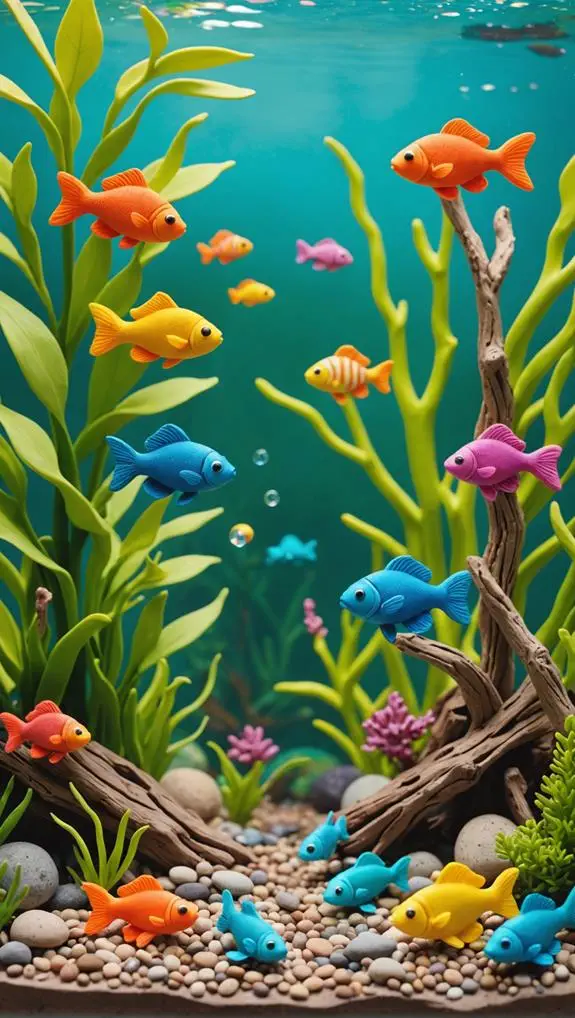
When it comes to keeping guppies healthy and happy, it's crucial to set up their environment just right. These little guys thrive in a tank with a temperature between 68-82°F and a pH of 6.5-8.0. So, let's dive into some essential care tips to ensure your guppies live their best lives!
- Tank Setup: Keep at least 2-3 males together to avoid aggression. A well-planted tank provides hiding spots and creates a stress-free environment.
- Diet: Guppies are omnivores, so mix it up! Feed them high-quality flakes or pellets, and treat them occasionally with veggies or live food. A varied diet keeps them vibrant and healthy.
- Water Changes: Regular water changes are vital. Aim for 25% every two weeks to maintain optimal water quality.
This helps keep your guppies happy and prevents any unwanted surprises!
White Cloud Minnow Insights
When it comes to keeping White Cloud Minnows, you'll want to set up the perfect tank conditions to help them thrive.
These little guys love cooler water and should hang out in groups to show off their fun social antics.
Plus, finding compatible fish isn't a headache, since they get along with most peaceful species, making them a great addition to your community aquarium!
Ideal Tank Conditions
Creating the perfect environment for White Cloud Mountain Minnows involves understanding their ideal tank conditions.
These easy-to-keep fish are perfect for beginners, and with a bit of effort, you can create a thriving habitat for them.
Here are three key factors to consider:
1. Tank Size & Setup: A small tank works, but aim for a well-planted aquarium with gentle water currents.
This not only enhances their comfort but also gives them plenty of space to swim and explore.
2. Group Dynamics: Keep these sociable minnows in groups of at least 5-10.
They thrive in numbers, which helps reduce stress and encourages natural behavior. Plus, watching them interact can be a joyous experience!
3. Water Quality: Regular water changes are essential. Aim for changing 10-20% of the tank water weekly to maintain optimal water quality.
Thankfully, these minnows show hardiness against fluctuating water parameters, making them forgiving if you forget a change occasionally.
Care and Maintenance Tips
Maintaining a healthy environment for your White Cloud Mountain Minnows is straightforward, and following a few care and maintenance tips will keep them thriving.
First off, remember that these small fish prefer a temperature between 64-72°F and a pH level of 6.5-8.0. Regular water changes are crucial to keep their habitat clean and healthy. Aim for about a 25% water change every two weeks—this helps maintain water quality and keeps your minnows happy!
Since these peaceful little guys thrive in groups, try to keep at least five together. This encourages their social behavior and reduces stress.
Feeding them is easy too! They enjoy a mix of flakes, small pellets, and occasional treats like brine shrimp.
For beginner aquarists, White Cloud Minnows are a dream. They're compatible with various community fish, so you can create a lively fish tank without worrying too much.
Just remember, regular water changes and filtration are key to their well-being, ensuring your tank remains a harmonious home for your aquatic friends.
With these care and maintenance tips, you'll be well on your way to having a thriving minnows' paradise!
Compatibility With Other Fish
White Cloud Mountain Minnows are almost always a great choice for community tanks due to their peaceful nature and compatibility with various fish species.
If you're looking to create a harmonious aquarium, you can't go wrong with these little guys. They thrive well with tetras, guppies, and other small, gentle fish.
To help you decide, here are three fish types that do well alongside White Cloud Minnows:
- Tetras – These colorful little fish share a similar temperament and can add vibrancy to your tank.
- Guppies – Known for their lively personalities, guppies make excellent tank mates and can coexist peacefully with minnows.
- Other Small Species – Any small, non-aggressive fish can usually fit right in without causing trouble.
Frequently Asked Questions
What Fish Is the Best for Beginners?
When choosing the best fish for beginners, consider Betta fish for their vibrant colors, or guppies for breeding fun. Neon tetras and zebra danios also thrive well, ensuring your fish tank setup remains enjoyable and engaging.
What Are the Best Low Maintenance Fish?
For low-maintenance fish, consider choosing hardy species like guppies or bettas. Ensure you've got a suitable tank size, ideal water temperature, and compatible species. Fish food options are simple, and health issues are minimal with proper care.
What Is the Friendliest Fish to Own?
When considering the friendliest fish to own, look into community aquariums. Guppies, neon tetras, and dwarf gouramis show great compatibility with beginner-friendly species, thriving in well-maintained setups and demonstrating positive fish behavior with suitable tank mates.
How Many Fish Should a Beginner Have?
Starting with 5 to 10 fish in your tank nurtures a thriving habitat. Use a fish compatibility chart, monitor water quality, and follow aquarium maintenance tips for feeding schedules and tank cycling to ensure their happiness.
Final Thoughts
So, diving into the world of fishkeeping is like planting a garden. Start with easy-to-care-for fish, and you'll watch your aquarium bloom with life and color! Goldfish, bettas, and guppies are just a few of the friendly faces waiting for your attention. With a little love and patience, you'll create a thriving underwater community. Remember, every fish has its quirks, just like us! Embrace the journey, and enjoy the splashes of joy they bring to your life.

